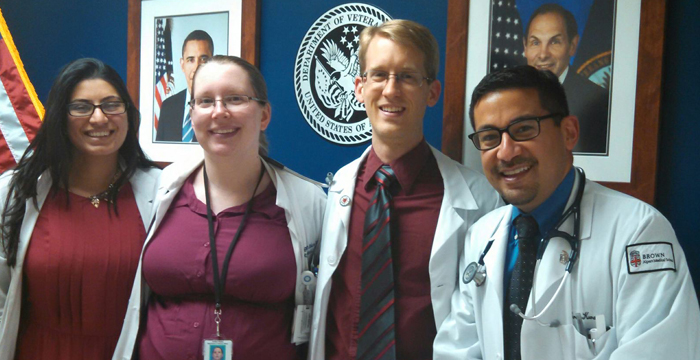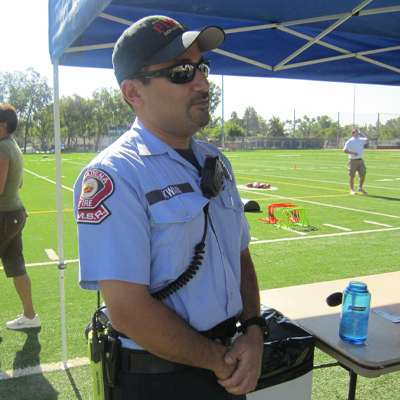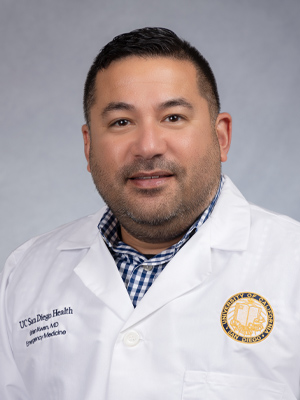Pioneering a new path: Dr. Brian Kwan’s Unconventional Path to Medicine

Brian Kwan, M.D. (right) attended medical school at Brown University and returned to California to complete his emergency medicine residency in Oakland before coming to UC San Diego initially for a fellowship in clinical informatics.
The American philosopher and poet Ralph Waldo Emerson is known for the saying, “Do not go where the path may lead; go instead where there is no path and leave a trail.” Emerson’s words of wisdom could easily describe the career of Brian Kwan, M.D., assistant clinical professor of emergency medicine at UC San Diego School of Medicine. Along his journey to becoming a physician, Kwan explored many passions and interests, forging a unique path that has allowed him to seamlessly integrate everything he loves into his role at UC San Diego today.

Brian Kwan, M.D., took a unconventional path to medicine including serving as an emergency medical technician and high school chemistry teacher prior to entering medical school.
The science of teaching
Kwan studied chemistry at Stanford University and then enrolled at California Institute of Technology to pursue a Ph.D. in medicinal chemistry, with the goal of working in drug development at a pharmaceutical company.
“Although I enjoyed the field, it took me a while to realize that working in the lab felt too solitary and ultimately was not the right fit. I decided to leave graduate school after earning my master’s degree,” he explained. “While I was in graduate school, I taught several courses for my mentor and had enjoyed the experience, so I decided to look for teaching jobs.”
After finishing his master’s degree, Kwan landed a job as a high school chemistry teacher at Loyola High School of Los Angeles. “I originally intended to stay for a year or two until I could decide what I wanted to do next. I ended up loving teaching and stayed at the high school for nine years. The school allowed me to explore different teaching methods and try interesting, new things,” he said.
Kwan developed several new resources for his students, including writing and publishing his own chemistry textbook. The textbook was more interactive than a traditional textbook and provided space for note taking and problem solving right in the book. “The basic information that high school students need to learn in chemistry hasn’t changed in centuries,” he explained. “It didn’t make sense for the school to invest new editions of a textbook every few years, so I developed my own textbook to better serve my students.”
He also adopted the “flipped classroom” method of teaching. Rather than delivering traditional lectures in class, Kwan began recording course content for students to start their learning outside of class, reserving class time for discussion and problem solving. He also customized an electronic homework system to generate individual student assignments with slightly different numbers and inputs, encouraging a collaborative approach to solving the homework problems. The system also provided individualized assessments to each student. “Being able to experiment with different technological solutions to improve the experience for my students made me realize that technology could be a very powerful tool in education,” he said.

Changing course
After several years of teaching, Kwan realized he was ready to make another career change. Inspiration for his next step came while he was on a backpacking trip where he experienced a serious medical situation. “Luckily everything ended up fine, but I realized I never wanted to be in that scenario again,” he explained. “I ended up taking a month-long wilderness EMT course the following summer at Yosemite National Park and learned that I really enjoyed working in emergency situations.”
After the course, he got a part-time job as an EMT with the Pasadena Fire Department, while maintaining his full-time teaching job. During his time as an EMT, he realized that medicine was the right next step. He went back to school at night to finish a few medical school prerequisites – while maintaining two jobs – and then took another year to study for the MCAT.
Kwan attended medical school at Brown University and returned to California to complete his emergency medicine residency at Highland Hospital in Oakland. It was during his residency that he realized he could combine his interests in medicine, technology and education into a future career.
During the first two years of residency, the hospital was using three different electronic medical records (EMR) systems that were not integrated with each other. “We really struggled from an informatics perspective,” he explained. “When the hospital decided to transition to one EMR, Epic, I was the only resident to volunteer to help with the rollout.” This experience led him to pursue a fellowship in clinical informatics at UC San Diego.
“There’s a lot of misinformation about informatics. Most people think you need a science or engineering background to work in the field, but you don’t. A lot of informatics is at its heart a sociotechnical endeavor – it’s really about the people who are seeing patients and actually doing the frontline work of health care.”
As a fellow at UC San Diego, Kwan worked on a project to improve how graduate medical education (GME) programs track procedure completion for residents and fellows. Historically, procedures were manually tracked in an education database that was separate from the EMR. He created a solution to merge clinical data from Epic into the separate education database, eliminating the need to manually enter the data.
“We use this data to decide if trainees are ready and qualified to work as independent physicians, so we should be using the most reliable data possible. All GME training programs could benefit from this solution,” he said.
His work was later published in JAMA Network Open in the paper, “An Automated System for Physician Trainee Procedure Logging via Electronic Health Records.”
The intersection of medicine, technology and education
Kwan’s work spans the School of Medicine’s tripartite mission of clinical care, research and education. He serves as the medical director for educational informatics at UC San Diego and is expanding previous informatics work in collaboration with other training programs, including general surgery, anesthesia, and the fellowship program in the Division of Cardiology. He is also exploring solutions for better tracking clinical experiences for third and fourth-year medical students in collaboration with another Brian Kwan, M.D., who is a professor in the Department of Medicine and director of the internal medicine clerkship at the School of Medicine.
“Medical students are currently manually logging patient cases they see during their clinical rotations,” Kwan said. “We are trying to use the data in Epic to assess the types of patient interactions medical students have in their clerkships so we can identify any critical gaps. This will allow us to redirect students to different types of patients as they progress through their clinical rotations to ensure they have a well-rounded clinical experience.”
He also has returned to teaching and is the new director of the Intro to Health Systems Science elective. In the course, first-year medical students gain exposure to the skills necessary to become effective leaders in modern health care, including teamwork, data interpretation, communication and advocacy.
Kwan credits mentors at UC San Diego for his success. “I really see my job as a collaboration with experts in medical education to figure out how we can use data to advance medical education,” he explained. “There aren’t many people currently doing this type of work in academic medicine. It is a privilege to be mentored by influential health care leaders in the Department of Emergency Medicine, Division of Biomedical Informatics and the Division of Medical Education. The support I’ve received shows that integration of education and technology is a priority for UC San Diego.”
— Stephanie Healey
Director of Communications, UC San Diego School of Medicine